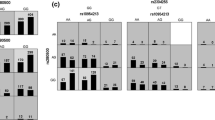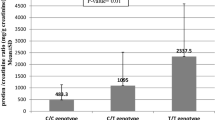Abstract
The expression of interferon inducible genes are reported to be heightened in systemic lupus erythematosus (SLE); nevertheless, not much is known regarding the genetic variants underlying these genes and their role in the pathogenesis of disease. Herein, we aim to explore the potential association and contribution of polymorphisms in MX1 gene (i) promoter with part of exon 1 (ii) intron 6, and (iii) their resulting haplotypes, with susceptibility to SLE. A total of 306 subjects, 152 SLE and 154 healthy controls (HC), were screened by direct sequencing method. Statistical analysis was carried out using appropriate software. The screening region of interest in MX1 revealed the existence of promoter (−123C/A, −88G/T, −20 A/C) and intron 6 (+9862G/A, +10190G/A, +9901C/G, +9920C/A, +9959C/T, +10047A/G) variants in SLE and HC. A significant association was observed between MX1 −88G/T SNP and susceptibility to SLE (χ 2 = 4.18, p = 0.04, OR = 1.89, 95 % CI 1.03–3.5). Haplotype analysis also revealed increased risk of SLE among individuals carrying CTA haplotype (−123 C, −88 T, −20 A) (χ 2 = 5.74, p = 0.017, OR = 4.28, 95 % CI 1.30–14.06). None of the other tested variants showed any significant association with SLE. The present study is the first to reveal the influence of genetic variation in MX1 gene in susceptibility to SLE.

Similar content being viewed by others
References
Bengtsson AA, Rylander L, Hagmar L et al (2002) Risk factors for developing systemic lupus erythematosus, a case–control study in southern Sweden. Rheumatology 41:563–571
Harley JB, Moser KL, Gaffney PM et al (1998) The genetics of human systemic lupus erythematosus. Curr Opin Immunol 10:690–696
Vyse TJ, Kotzin BL (1996) Genetic basis of systemic lupus erythematosus. Curr Opin Immunol 8:843–851
Bengtsson AA, Sturfelt G, Truedsson L et al (2000) Activation of type I interferon system in systemic lupus erythematosus correlates with disease activity but not with antiretroviral antibodies. Lupus 9:664–671
Braun D, Geraldes P, Demengeot J (2003) Type I interferon controls the onset and severity of autoimmune manifestations in lpr mice. J Autoimmun 20:15–25
Kalkner KM, Ronnblom L, Karlsson Parra AK, Bengtsson M, Olsson Y, Oberg K (1998) Antibodies against double-stranded DNA and development of polymyositis during treatment with interferon. QJM 91:393–399
Mathian A, Weinberg A, Gallegos M, Banchereau J, Koutouzov S (2005) IFN induces early lethal lupus in preautoimmune (New Zealand Black × New Zealand White) F1 but not in BALB/c mice. J Immunol 174:2499–2506
Baechler EC, Batliwalla FM, Karypis G et al (2003) Interferon-inducible gene expression signature in peripheral blood cells of patients with severe lupus. Proc Natl Acad Sci U S A 100:2610–2615
Bennett L, Palucka AK, Arce E et al (2003) Interferon and granulopoiesis signatures in systemic lupus erythematosus blood. J Exp Med 197:711–723
Crow MK, Wohlgemuth J (2003) Microarray analysis of gene expression in lupus. Arthritis Res Ther 5:279–287
Han GM, Chen SL, Shen N, Ye S, Bao CD, Gu YY (2003) Analysis of gene expression profiles in human systemic lupus erythematosus using oligonucleotide microarray. Genes Immun 4:177–186
Goldacre MJ, Wotton CJ, Seagroatt V, Yeates D (2004) Cancers and immune related diseases associated with Down’s syndrome, a record linkage study. Arch Dis Child 89:1014–1017
Watanabe S, Imaizumi T, Tsuruga K et al (2013) Glomerular expression of myxovirus resistance protein 1 in human mesangial cells, possible activation of innate immunity in the pathogenesis of lupus nephritis. Nephrology (Carlton) 18:833–837
Feng X, Wu H, Grossman JM et al (2006) Association of increased interferon-inducible gene expression with disease activity and lupus nephritis in patients with systemic lupus erythematosus. Arthritis Rheum 54:2951–2962
Coit P, Jeffries M, Altorok N et al (2013) Genome-wide DNA methylation study suggests epigenetic accessibility and transcriptional poising of interferon-regulated genes in naïve CD4+ T cells from lupus patients. J Autoimmun 43:78–84
Tazi-Ahnini R, di Giovine FS, McDonagh AJG et al (2000) Structure and polymorphism of the human gene for the interferon-induced p78 protein (MX1), evidence of association with alopecia areata in the Down syndrome region. Hum Genet 106:639–645
Torisu H, Kusuhara K, Kira R, Bassuny WM, Sakai Y, Sanefuji M, Takemoto M, Hara T (2004) Functional MxA promoter polymorphism associated with subacute sclerosing panencephalitis. Neurology 62:457–460
Barrett JC, Fry B, Maller J, Daly MJ (2005) Haploview, analysis and visualization of LD and haplotype maps. Bioinformatics 21:263–265
Rousset F (2008) Genepop'007; a complete reimplementation of the Genepop software for Windows and Linux. Mol Ecol Resour 8:103–106
Glymph S, Mandal S, Knowell AE, Abebe F, Chaudhary J (2013) The myxovirus resistance A (MxA) gene -88G> T single nucleotide polymorphism is associated with prostate cancer. Infect Genet Evol 16:186–190
Hamano E, Hijikata M, Itoyama S et al (2005) Polymorphisms of interferon inducible genes OAS-1 and MxA associated with SARS in the Vietnamese population. Biochem Biophys Res Commun 329:1234–1239
Hijikata M, Mishiro S, Miyamoto C, Furuichi Y, Hashimoto M, Ohta Y (2001) Genetic polymorphism of the MxA gene promoter and interferon responsiveness of hepatitis C patients, revisited by analyzing two SNP sites (−123 and −88) in vivo and in vitro. Intervirology 44:379–382
Zhang X, Xu H, Chen X et al (2014) Association of functional polymorphisms in the MxA gene with susceptibility to enterovirus 71 infection. Hum Genet 133:187–197
Hu CH, Chen J, Yang R et al (2012) Association between single nucleotide polymorphisms in −88 and −123 loci of MxA gene promoter region and HCV susceptibility and IFN-α efficacy. Xi Bao Yu Fen Zi Mian Yi Xue Za Zhi 28:1307–1310
Ma SL, Huang W, Tang NL, Lam LC (2012) MxA polymorphisms are associated with risk and age-at-onset in Alzheimer disease and accelerated cognitive decline in Chinese elders. Rejuvenation Res 15:516–522
Fernandez-Arcas N, Blanco A, Gaitan MJ, Nyqvist M, Alonso A, Reyes-Engel A (2004) Differential transcriptional expresion of the polymorphic myxovirus resistance protein A in response to interferonalpha treatment. Pharmacogenetics 14:189–193
Furuyama H, Chiba S, Okabayashi T et al (2006) Single nucleotide polymorphisms and functional analysis of MxA promoter region in multiple sclerosis. J Neurol Sci 249:153–157
Speiser DE, Zurcher T, Ramseier H et al (1990) Nuclear myxovirus-resistance protein Mx is a minor histocompatibility antigen. Proc Natl Acad Sci U S A 87:2021–2025
Li Y, Youssoufian H (1997) MxA overexpression reveals a common genetic link in four Fanconi anemia complementation groups. J Clin Invest 100:2873–2880
Acknowledgments
This work was supported by the Kuwait University Research Administration grant NM 02/07.
Author information
Authors and Affiliations
Corresponding author
Ethics declarations
Disclosures
None.
Ethics approval
The conduct of the study was approved by the institution’s ethics committee and all the participants provided written informed consent.
Electronic supplementary material
Below is the link to the electronic supplementary material.
Supplementary Figure 2
Graphical Overview of Linkage Disequilibrium (GOLD) plot showing pair-wise intermarker Linkage disequilibrium in terms of D' between all the identified nine SNPs of the MX1 gene. (JPG 49 kb)
Rights and permissions
About this article
Cite this article
AlFadhli, S., Al-Mutairi, M., Al Tameemi, B. et al. Influence of MX1 promoter rs2071430 G/T polymorphism on susceptibility to systemic lupus erythematosus. Clin Rheumatol 35, 623–629 (2016). https://doi.org/10.1007/s10067-016-3179-z
Received:
Revised:
Accepted:
Published:
Issue Date:
DOI: https://doi.org/10.1007/s10067-016-3179-z




